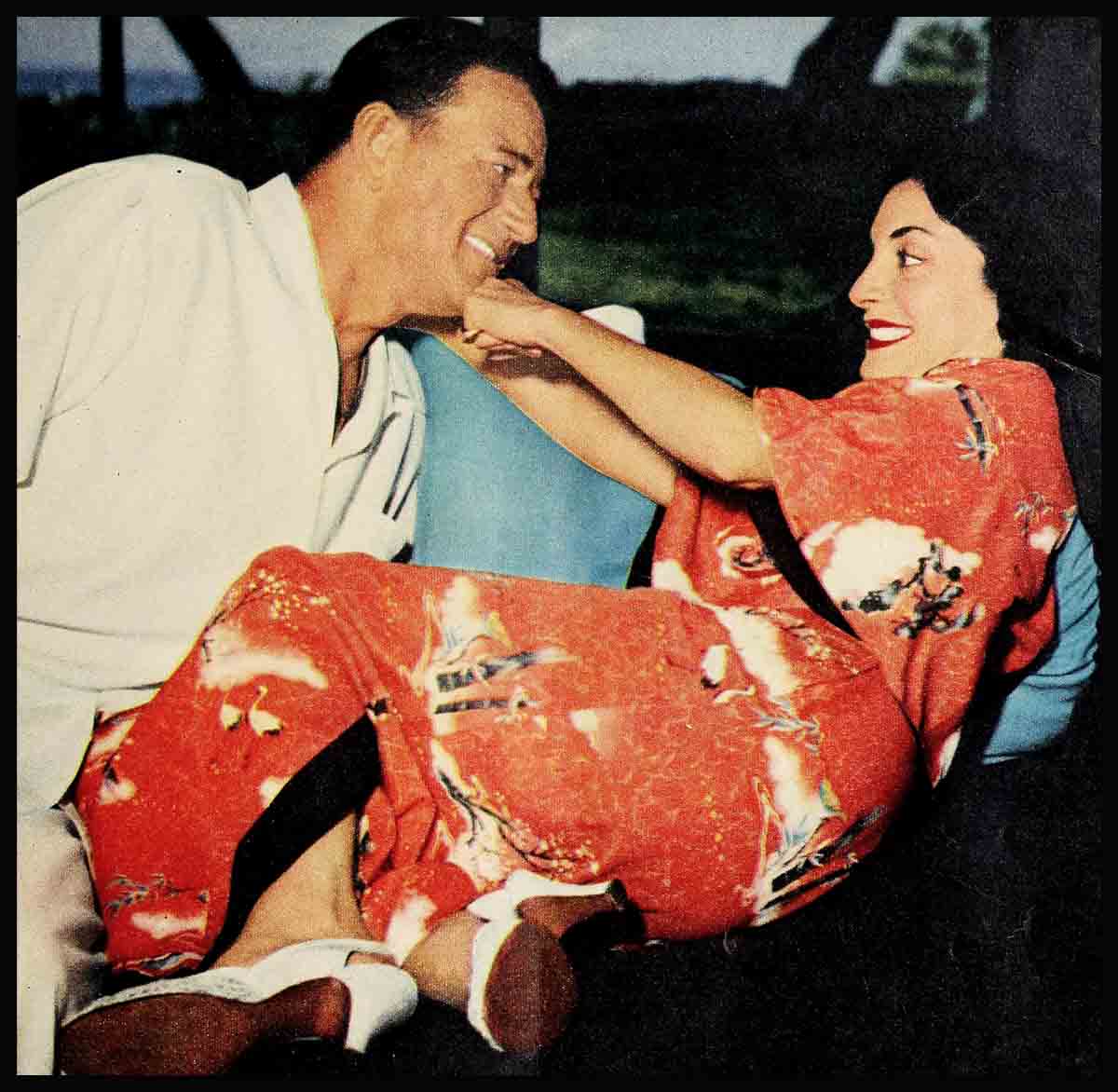
The Duke Goes West—John Wayne & Pilar Palette
When John Wayne read the letter informing him that he would have to travel to Hawaii to film The Sea Chasehe frowned deeply.
Later on in the afternoon, Pilar Pallete, Wayne’s fiancée, joined him on the patio.
“How would you like to take a little trip?” he asked.
“Where now?” Pilar answered. “It seems to me you’d like to stay around your house for a while after spending the summer in Utah.”
“Hawaii,” said Wayne. “A location.”
“Oh, no!” Pilar groaned. “For how long?”
“Couple of months,” said Wayne.
“I’ll miss you,” Pilar said.
“We’ll have a lot of fun,” said Wayne.
“I’ll write you every day,” said Pilar.
“It’s beautiful in Hawaii,” said Wayne. “Mary (his secretary) can be a chaperone.”
“And by the time you get back,” said Pilar, “I’ll have the house completely finished. I’ll bet you won’t even know the place.”
“We could leave a little ahead of time and have a vacation on the boat,” said Wayne.
“I don’t think much of a girl,” Pilar said, “who follows a man everywhere he goes. Traipsing after him like a cocker spaniel.”
“Neither do I,” said Wayne, “unless she’s crazy about him.”
“I’ll really miss you,” said Pilar.
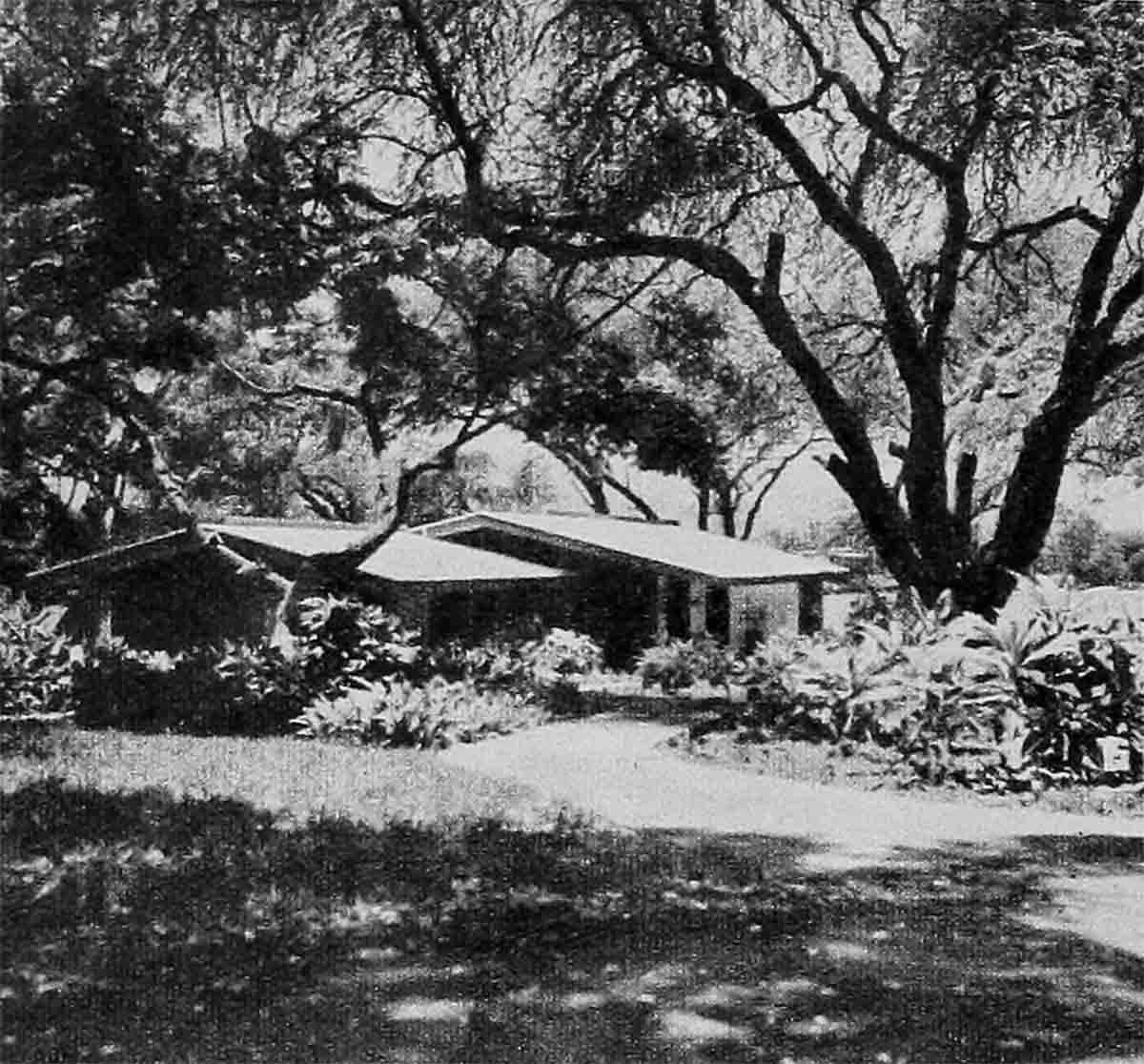
One week later the Lurline, the magnificent floating palace of the Matson Line, stood ready at the dock in Wilmington, California, while the passengers streamed aboard. A thousand relatives and friends lined the plank platform beside the ship waving goodbye to a thousand travelers lining the rails. Sailing parties were just breaking up in the cabins. A dozen or so guests still milled around in Wayne’s cabin, reluctant to go ashore. Pilar Pallete was talking with Michael, Wayne’s eldest son, who was going along. Wayne joined them.
“Why don’t you and Mary go to your cabin and freshen up before we sail,” Wayne said to her.
“I will go,” said Pilar, “if you will just explain one thing to me. How is it I am going on this trip? Didn’t you hear me when I said I wouldn’t go?”
“Sure I did,” said Wayne grinning. “But you’re just a little cocker spaniel—and you’re crazy about me.”
The Royal Hawaiian Hotel at Honolulu may never be the same. When John Wayne vacations he does so in an elegant and expansive manner. The trip over had been fun. The Wayne party included his son, his business manager, B. C. Roos, and Mrs. Roos,a Panamanian banker and diplomat, Tony Arias and his wife, Mary St. John, his secretary, and the cocker spaniel. A relentless perfectionist when he works, John Wayne is also a tireless playboy when he plays—and the voyage had been an endless round of games and rousing dinner and cocktail parties. The group took over half a floor of the Royal Hawaiian.
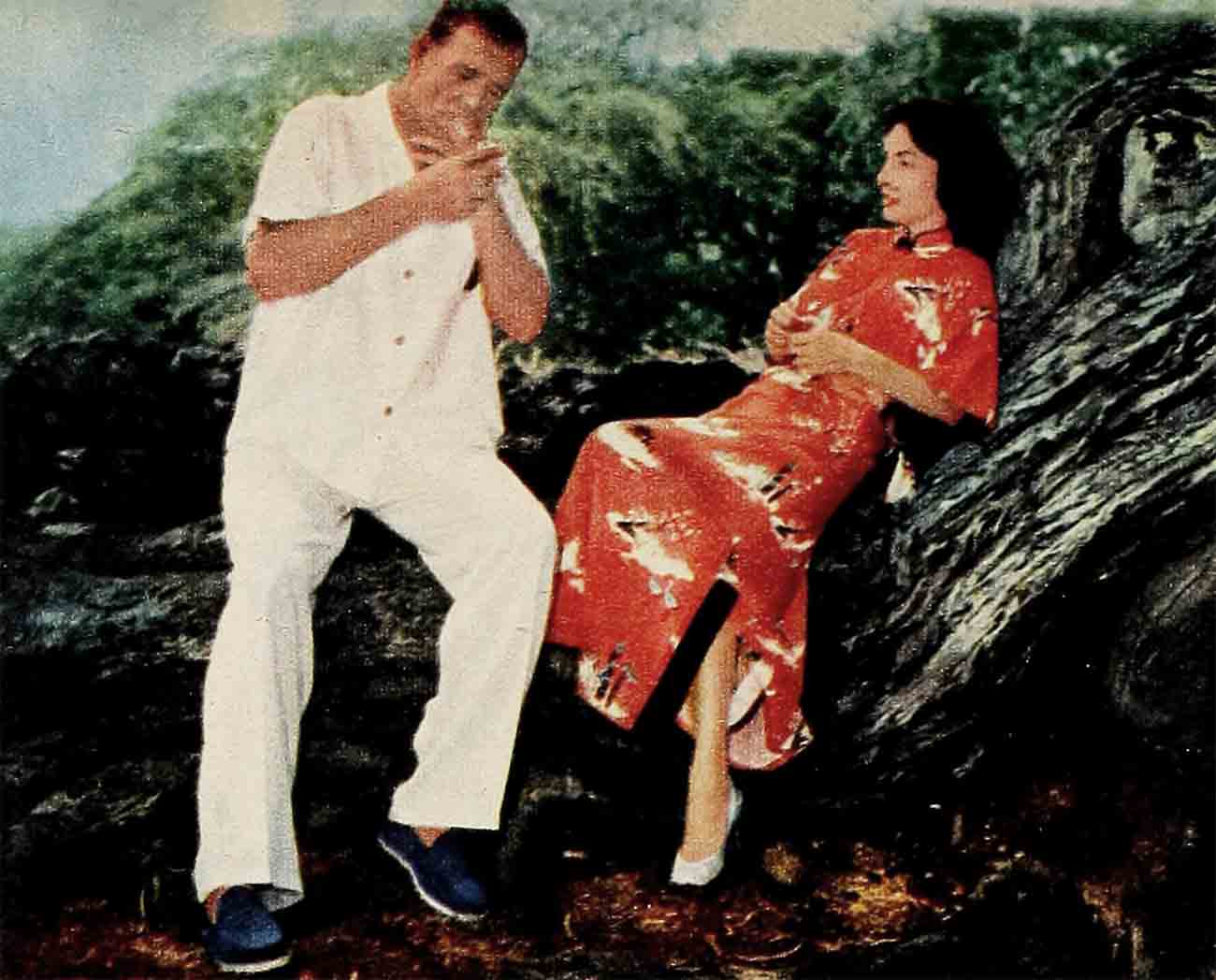
There are hotels in Honolulu that specialize in freedom of action and casual attire for guests but the Royal Hawaiian is not one of them. Natives call it the Pink Castle because it is painted pink and resembles a citadel of respectability and decorum jutting out somewhat reservedly onto Waikiki beach. You eat your meals at regular hours at The Royal Hawaiian and you don’t go about in the bars and cafe without a jacket. And a couple of nights a week you wear a dinner jacket or an evening gown to supper.
After a pleasant dinner the day before Pilar’s birthday, everyone retired to the hotel for a few last stories and a nightcap in Duke’s suite. About eleven o’clock Wayne spoke to Pilar.
“Look,” he said, “you’re going to have a very busy day tomorrow. Why don’t you go to bed and get some rest?”
“I’m not tired,” said Pilar.
“To bed!” said Wayne. And Pilar went.
She had just fallen asleep. It was one minute past midnight, the dawn of her birthday. Suddenly the door of her room was thrown open. In filed an entire Hawaiian orchestra, complete even to a trio of native singers. Someone flicked on a light and the music began. Pilar opened her eyes in disbelief. The troubadors filled the entire wing with their music and song.
“Happy birthday to you! Happy birthday to you!”
They sang the song twice and then Duke, grinning from ear to ear, told her to get up on her feet and get dressed, there was going to be a party.
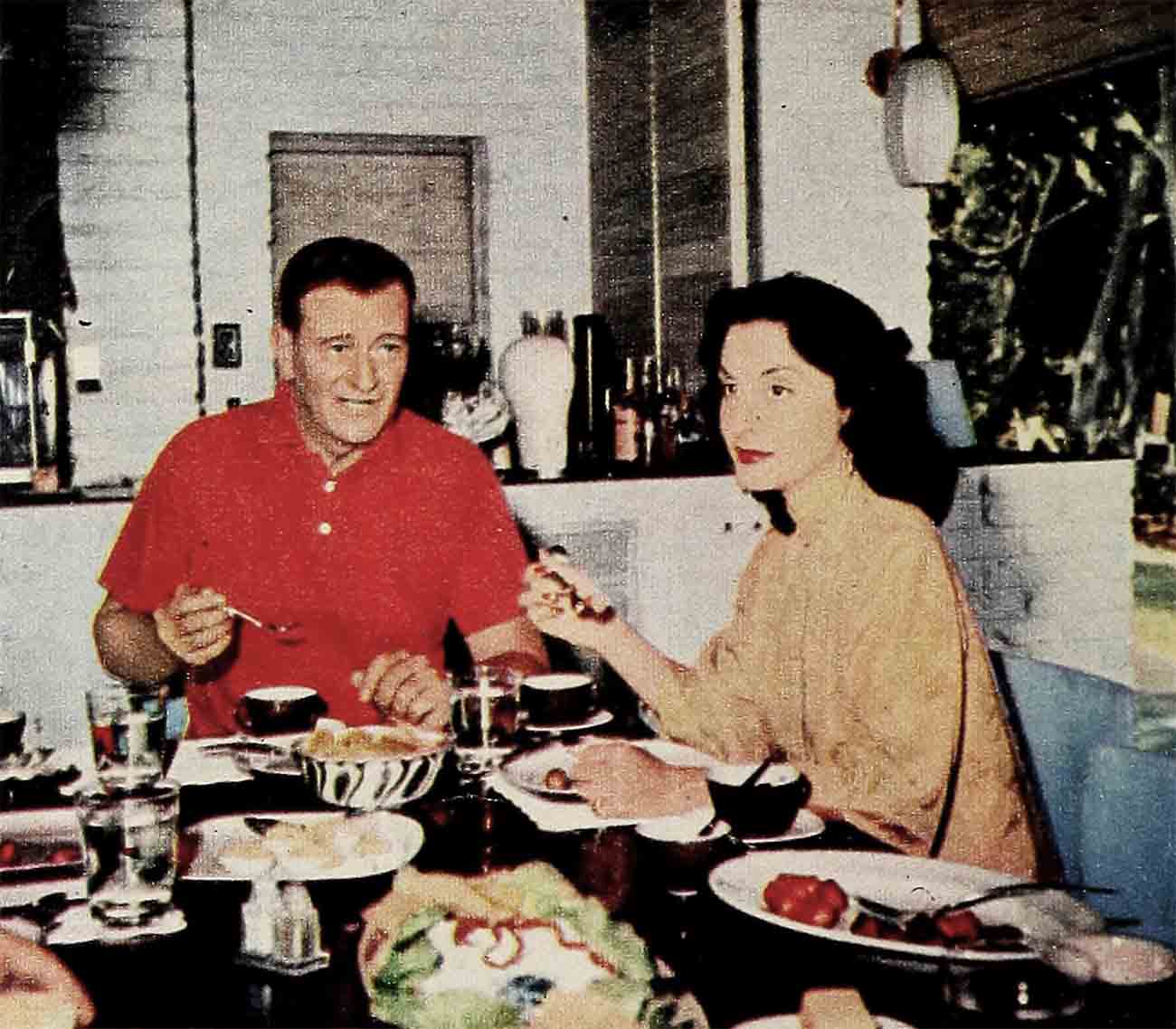
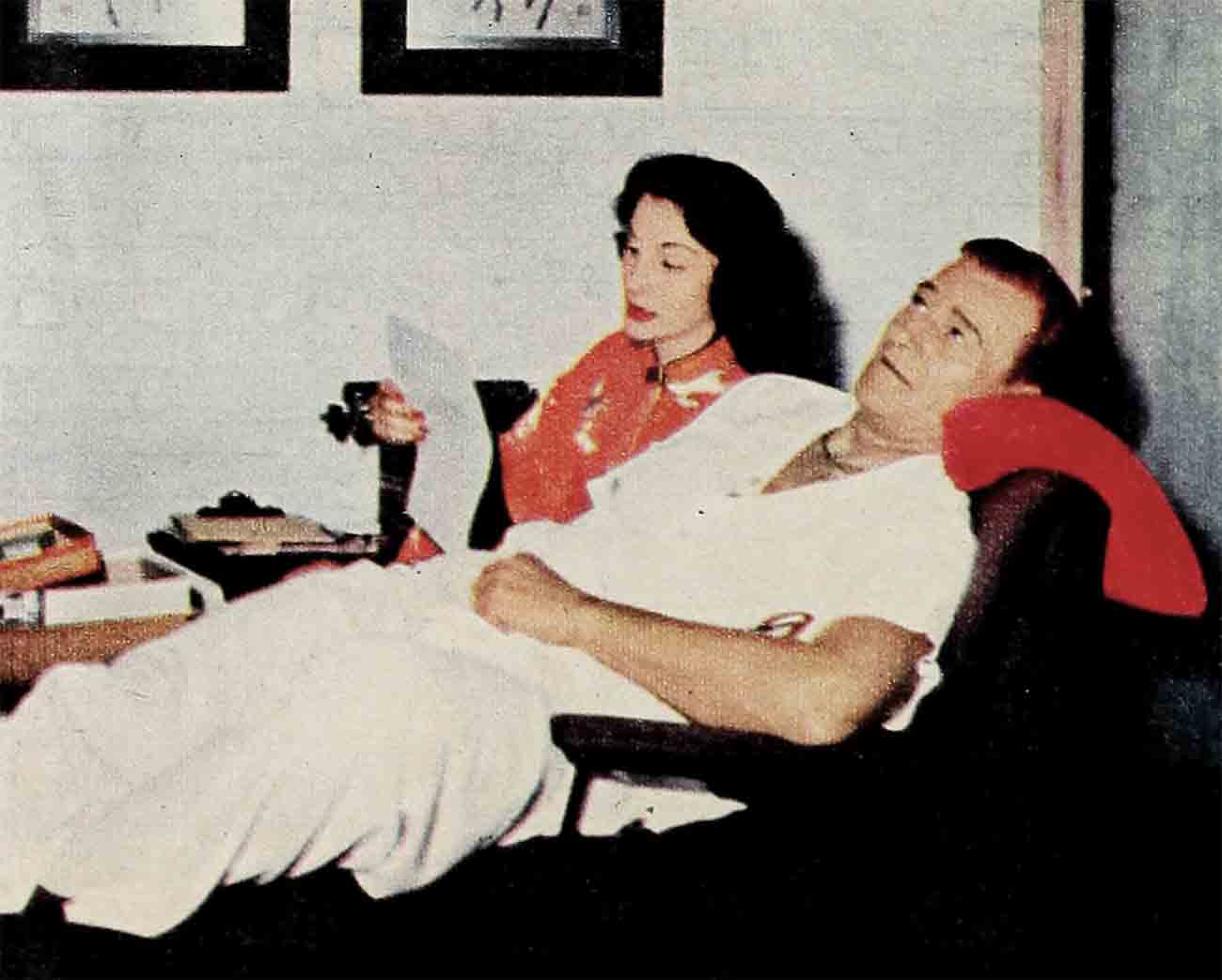
And it was a party for fair. Pilar was whisked by her friends in a sleek, black limousine down the street to Don The Beachcomber’s where the large banquet room had been reserved and had been filling up with scores of people for an hour. When she arrived, the birthday song was sung again and a hundred and thirty glasses were raised high in a toast to Pilar’s health. The cream of the Island society was there:and a good sprinkling of Hollywood folk. Mrs. John Ford and her daughter Barbara and Barbara’s husband, Ken Curtis. The Van Heflins, the William Bendixes and many others. Along one side of the room the entire wall had been transformed into a magnificent birthday card, with “HAPPY BIRTHDAY, PILAR” spelled out in script fashioned from thousands of orchids.
The merrymaking went on well into the morning and at the end, when Duke was driving her home, Pilar turned to him.
“Now I know,” she said, “why I came along on this trip.”
“Now you know,” said Duke. ‘You’re really not a cocker spaniel. I just wanted us to be together on your birthday.”
But one day the vacation was over. The time had come to go to work. And the location wasn’t in Honolulu.
“There’s no point in your going home now,” Duke told Pilar. “Mary is coming along and you can get a nice place at the Kona Inn. The studio has found me a little house and we can have fun evenings and on week-ends. What do you say?”
“Why do you talk so much?” said Pilar. “Make the reservations.”
And so, the next morning, one of the sturdy little airplanes of the Aloha Airlines made a wide sweep off the Kona Coast of the big island of Hawaii, a hundred and seventy miles south of Honolulu and came to rest at the edge of the village of Kailua.
The party drove to the house. The Kailua area is made up of jungle and lava flows. The jungle is thick and lush and very green and the beds of the lava flows are black to dark brown rivers of cinders and solid rock that have frozen into a million different shapes as the anger of Mauna Loa, her crater hiding high in the clouds, subsided. But there is still excitement in the lava flows, because Mauna Loa is active and as recently as 1952 spilled millions of acres of molten rock down into the sea right at the edge of the village.
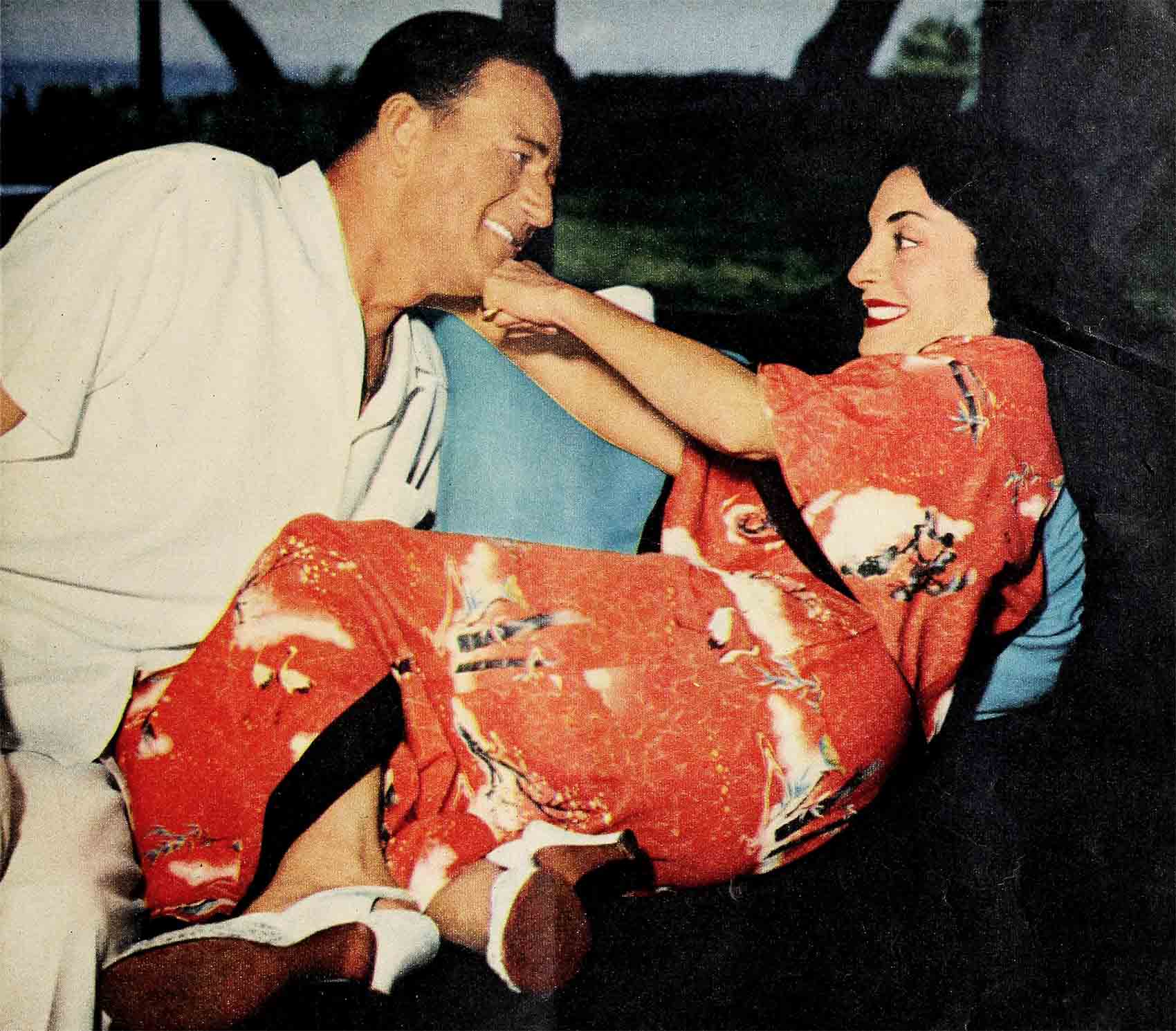
Duke and Pilar’s car traversed a black hard road which had been built of crushed lava. It cut through the jungle, halting now and then to ease past crews of native boys who spent their days chopping down the growth which built up overnight. And then they came to the house, one of the most modern to be found in any corner of the world. It is open on all sides except for screens that keep out the hordes of flying insects that abound in the area. The main walls are of stained koa wood and alternate sections of white-painted brick. There is no convenience known that the owners, Senator and Ouida Hill of Hilo, Hawaii, have left out. But it is the setting of the house that is breathtaking.
The house is built on a promonotory of black lava on the beautiful bay of Keauhou (pronounced key-ah-hoe) and around a semi-circle of palms and fragrant bushes lie the primitive homes of the native fishermen, each family with its bright red outrigger canoe pulled ashore onto a skidway of small logs.
Duke and Pilar stood and watched the activity for a long time before they went into the house. Across the small bay children of four and five were sporting in the warm water, swimming like Olympic champions. And from another bank a man and his wife went to sea after urchins, spiny cactus-like creatures that cling to the coral and rocks on the bottom. The man swam ahead and his wife followed ten feet behind towing on a rope a washtub that would carry their catch. Some distance from shore the man began his dives. He would plunge to the floor of the sea and, with a wire fork on the end of a short stick, snatch several urchins from their homes, bring them to the top and toss them in the tub. When they got to shore they offered Duke and Pilar some of their prizes, explaining that the poisonous spines must be broken off, the crusty skin of the fish opened and the meat eaten alive and raw. Duke and Pilar said they just weren’t hungry.
Any location trip during the making of a movie is rough, but The Sea Chase jaunt to Hawaii was a honey. The locale was a cove where the jungle grew thick right to the water’s edge. There was anchored a large, rusty ship, looking so likely to sink that when it first dropped anchor off the jetty at Kailua all the natives for miles around came to look at it.
At six o’clock in the morning, Pilar and Mary St. John, still half asleep themselves, would come trotting down the road to the house, ringing a bell to awaken Duke. Then, while he dressed, they would prepare breakfast for him. And at a quarter to seven Duke would dash across the lava flow to a waiting car, which drove him to the jetty, where he boarded the ship for a long day of shooting at sea.
The evenings were fun, though. Duke would return to the house about six o’clock. He would join Pilar and Mary and any other guests who might be there in a half hour of swimming in the warm water of the bay. Then would come an hour of walking and exploring the rock-lined shores for shells or boating with a glass viewer to observe the lovely coral.
At about seven-thirty, dinner, prepared by a local Portuguese woman named Laura and her daughter Rose, would be served.
Another hour of chess, cribbage or gin rummy and Duke’s eyes would begin to close, so Pilar and Mary would send him off to bed and then return to their own quarters for a bit of the same tonic.
Sundays were generally gay. Duke and Pilar would swim several times, fish a lot and take long siestas on the wide, flat benches on the lawn. And if they had the energy they would skin-dive (Pilar became a very proficient skin-diver) and bring back all manner of strange finny creatures for Laura to cook for lunch. Sometimes, although they preferred being alone, Duke and Pilar would ask other members of the company to come over for cocktails. And one week-end, when a guest arrived from the mainland, they threw a bang-up party. From the names of the guests it might have taken place in Beverly Hills. Duke’s son Pat was there and Henry Fonda and Mr. and Mrs. Ward Bond and the director, John Farrow, and Lana Turner and a half dozen others.
But the entertainment was different. Just as coffee was being served after dinner, a strange procession appeared a hundred yards from the house where the lava flow ran into the sea. A group of white-garbed natives carrying torches and several shrouded shapes walked slowly to the water’s edge, chanting a dirge in a strange tongue. At the water’s edge they raised the torches high and cast their burdens into the sea. The guests were awed.
“That,” said Duke, “is a Hawaiian burial service. The lava beds are too hard to dig, so the natives bury their dead by torchlight in that manner.”
When it was all over, Henry Fonda approached one of the musicians.
“That was a very impressive chant you were singing during the burial,” he said. “What do you call it?”
The Hawaiian grinned. “That was a joke we played on you,” he said. “And when we chanted, we just kept repeating ‘We are crazy Hawaiians.’ ”
The vacation or location, whichever you wish to call it, is over now and Duke and Pilar are back home in Hollywood. But there is one incident they won’t soon forget.
Duke fell ill. He got an infection in his ear that was extremely painful and, for a while, really serious. He is a big man, proud of his size and his ability to take anything. But this tiny bug laid him low. A doctor was called from Honolulu who ordered him immediately to a hospital in Hilo on the other side of the mountain.
Pilar bundled her man into a car, covered him with blankets against the chill night air of the mountain top, and, driven by a native boy, they traveled to Hilo where Duke was given emergency treatment and put to bed at the Naniloa Hotel. He passed into a deep sleep induced by the illness, the fatigue of the drive and the medication. When he awakened in the morning the first thing he saw was Pilar curled up with a blanket on a chaise longue across the room. She hadn’t slept. Duke gave her a weak grin.
“What are you doing here?” he asked. “Away over here in Hawaii, three thousand miles from home!”
Pilar was wan, but she managed to smile. “I’m just a cocker spaniel,” she said. “And I’m crazy about you. And now I really know why I came on this trip. Go back to sleep. I’ll watch over you.”
It was a surprise to no one that in the first week of November Duke and Pilar were married in Honolulu. District Magistrate Norman Olds performed the single-ring ceremony in the garden of Territorial Senator William H. Hill. The word “obey” was omitted, perhaps to persuade Pilar that she isn’t treated like a cocker spaniel!
THE END
—BY JACK WADE
It is a quote. MODERN SCREEN MAGAZINE JANUARY 1955




